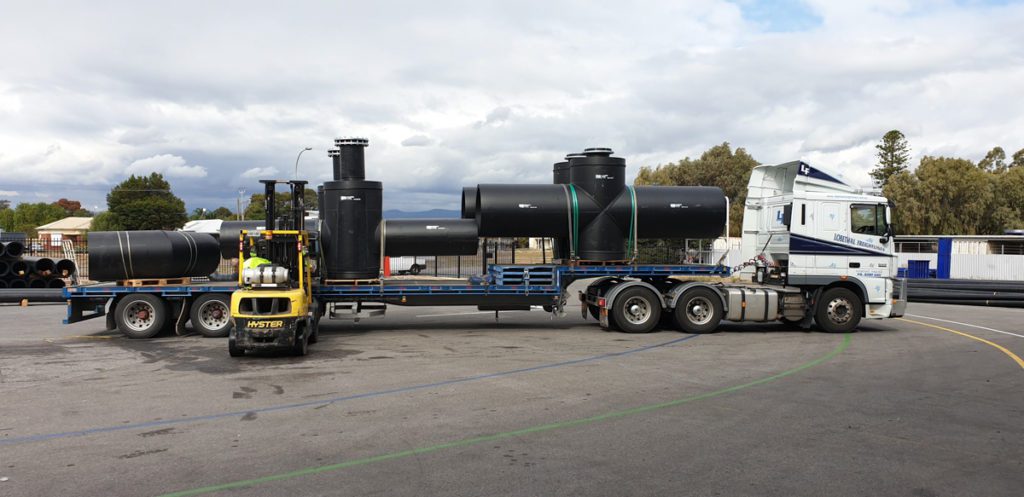Don’t get caught out: the benefits of catch pits

Across the globe, catch pits play a vital role in wastewater and water management systems, with benefits including helping to prevent costly blockages, flooding and water contamination.
But even though this ingenious device has been around for decades, catch pits remain a relatively new feature of Australian drainage and irrigation systems.
As their name suggests, catch pits are an empty chamber that is built into a watercourse to ‘catch’ debris carried along the drainage pipe by the water.
They are generally used in areas with a lot of sediment, debris like rocks and grit, or solid contamination in the water, such as main line storm water drainage systems, also used to manage water along Water Channels for Rural Irrigation purposes.
Advanced Piping Systems was the first company in Australia to design and supply a custom-built catch pit for a water authority in Australia.
In this article we explain how this bespoke catch pit helped one region save a staggering amount of water, and how you can install and maintain a catchpit for yourself.
The benefits of a catch pit
The north of Victoria produces more fruit and dairy produce than any other region in Australia, as well as significant general horticulture and mixed farming.
As Australia’s ‘food bowl’, it is also Australia’s largest irrigation district.
Two years’ ago, after establishing a need to upgrade their irrigation channels, the water authority in the area enlisted the help of Advanced Piping Systems.
“Throughout the region, they’ve got water wheels to gauge water flow down the channel, which goes onto private properties,” explains Melvin Joyce, Advanced Piping Systems’ Area Sales Manager for Victoria
“The amount of flow generated was used to gauge usage – but the wheels kept getting jammed, which meant farmers were using more water than what they were measuring.”
In addition to gauging more accurate data on water usage, the water authority also wanted to filter out any contaminants and debris from the channel, too.
To address these two problems, the team at Advanced Piping Systems designed and fabricated a custom catch pit.
“We developed a bespoke design,” said Melvin.
“The main line drops into a big catch area (a 1200mm diameter pit), and from there, the water simply rises to the level of the mainstream outlet.
“As it drops down, all debris falls out and the water rises and goes out at a different level.
“The idea is that the farmer, or the water authority, can take out the debris and catch any contamination in the water that would interfere with the measuring system.
“It’s foolproof!”
Since the water channel upgrade, which includes many custom catch pits in the HDPE pipeline, the water authority has been able to save an impressive 68 gigalitres – or 68 billion litres – of water.
Installing a catch pit
At Advanced Piping Systems, we specialise in custom design and builds.
Once a custom catch pit has been designed to suit our customers’ needs, we have the ability to build it at our in-fabrication shop, before transporting it to site. Once it arrives at the site, installation is fairly straightforward.
“Installation is quite simple when upgrading a pipe line to HDPE pipe, but you will need a HDPE welding contractor to be onsite.
“The first step is to excavate an area to allow for the catch pit to sit low enough so the mainstream inlet pipe will connect to the catch pit.
“Secondly, ensure the base is firmly supported under the catch pit to avoid stress on the pipe connections.
“The third step involves connecting the outlet.
“You need to excavate an area to connect the outlet pipe to the opposite side of the catch pit, at the correct level, to ensure the base of the pipe is supported.”
Maintaining a catchpit
With the ability to prevent blockages, flooding and water contamination – plus save water and increase the accuracy of water-usage data – the benefits of catch pits are significant.
However, in order to ensure their reliability and optimum functionality, it is important that you clean and maintain your catchpits regularly – particularly during winter, explains Melvin.
“It is essential that catch pits are regularly maintained – especially when there is additional debris flowing down the water way, like in winter, when you get more water movement.”
“This ensures the debris inside does not impact on flow, by entering the outlet pipe or causing a blockage within the catch pit.”
If you think a catch pit could be the solution to your irrigation or wastewater management troubles, contact Advanced Piping Systems today.

